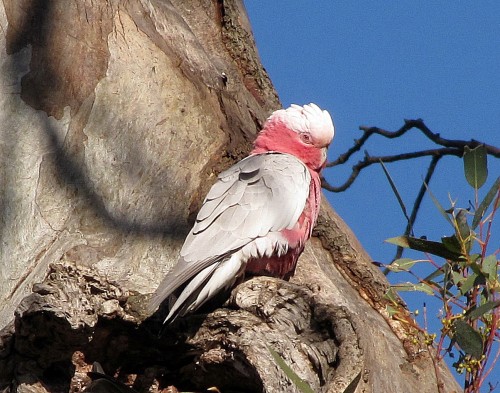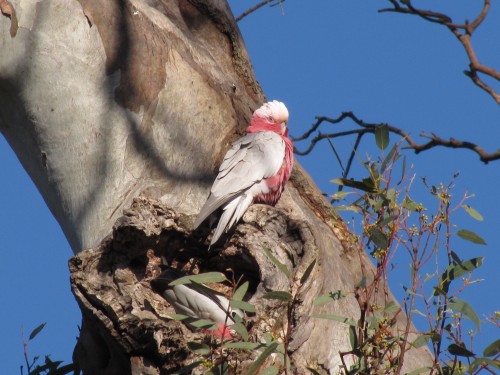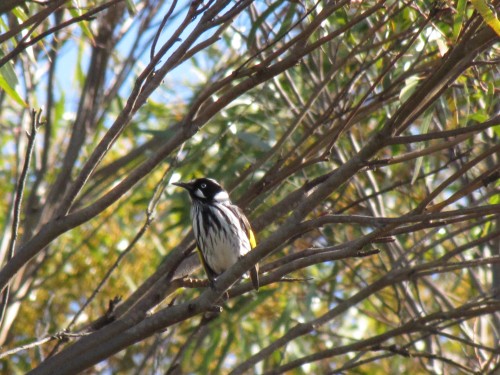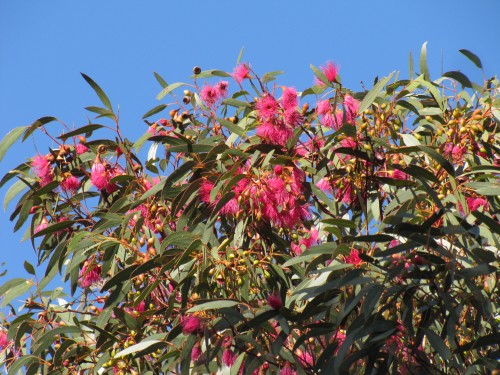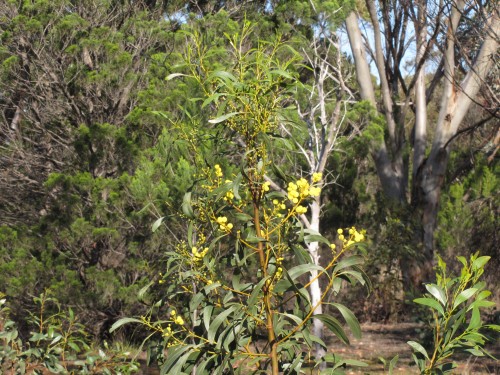Where’s my camera?
Last Friday my wife had a medical appointment in Adelaide. It was an early morning appointment which meant that we had most of the day to do other things. Instead of taking the quick way home via the south eastern freeway we took a far more interesting route home. We drove up through the Adelaide Hills (part of the Mt Lofty Ranges) via Gorge Road. Along the way we stopped for an extended cup of tea and delicious scones at the Big Rocking Horse at Gumeracha.
I was about to grab my camera to take some photos of the world’s largest rocking horse and some of the local bird life when I realised I had left my camera at home. I had remembered my note book and a pen to record what I saw, I had remembered my binoculars and a field guide resides permanently in the car so I don’t have to remember it. But no camera. Doh.
Oh well, I just had to be content with doing some birding via the naked eye. (Can one say “naked eye” when I do have the assistance of glasses?) Still, birding without either a camera or binoculars is good for honing one’s observation skills. I had also left the binoculars in the car while we sat in the warm restaurant having morning tea. The large picture windows make viewing the nearby landscape extremely easy and delightful.
So, without the help of any visual aids I managed to following list of birds:
- Common Blackbird
- New Holland Honeyeater
- Galah
- Little Raven
- Crimson Rosella (Adelaide Rosella)
- White Ibis
- Rainbow Lorikeet
- Australian Magpie
- Sulphur-crested Cockatoo.
- Australian Wood Duck
That’s not a great list but the conditions were difficult for the following reasons:
- It was very cold and not many birds were active
- The weather was heavily overcast and gloomy
- The scones were delicious and needed my full attention
- My wife an I were in deep conversation for over an hour discussing an important life decision I need to make shortly.
Happy birding.
Trevor
Two interesting birding blogs
It has been a while since I last featured other birding blogs here on my site. With all the writing I do, and other pressing responsibilities that life hurls at me from time to time, I don’t get nearly enough time to read many other sites about birds.
I hope to correct that oversight in coming weeks. Today I am going to feature two contrasting yet wonderful blogs, one about wildlife in general and the other specifically about birds and as a bonus, an article about bird photography.
Naturally South Australia features the ‘fascinating wild places and animals that define South Australia.’ Written and photographed by South Australian teacher and author Barry Silkstone, this blog highlights many of the things I love about my state. Of course he features many bird photos on a regular basis, and as a bonus you get photos of our animals as well. As a further bonus he writes about and photographs many of the places that make South Australia such a wonderful holiday destination, as well as a great place to live.
On the other hand Lirra Lirra: the magical mystery of birds is something else again. The author features only birds with photographs of the highest quality. Just the few featured on one recent post about Fairy-wrens made me almost weep for joy and total admiration – no, I am in awe. This site sent me scurrying to first check my bank balance, and then some camera shop sites. I thought some of my photos were rather good – until I saw this site. I really need to upgrade my camera equipment. Seriously upgrade. Sigh.
And while I am on the topic of bird photography, a few days ago I came across this article called 10 Tips for Photographing Birds. It includes some great ideas and hints on taking great shots of our wonderful birdlife.
Good birding – happy photography.
Trevor
Birding at Browns Road Monarto
This afternoon my wife and I took a detour coming home from Mt Barker in the Adelaide Hills. We had been there for a appointment, after which we had a relaxing lunch in one of the local cafes. Instead of taking the South-Eastern Freeway home to Murray Bridge we took the old Princes Highway route. It is a longer, more circuitous route but far more interesting.
Just past Callington we turned off into Browns Road near Monarto. We stopped at a spot where we could park the car safely before going on a short walk through the scrub. The sign on the gate says “Monarto Woodlands” but local birders usually refer to this area as Browns Road.
The scrub here is a confusing mixture of plant species. While there are some species common to the surrounding region, many of the trees and shrubs are introduced from other parts of Australia. A quick glance shows many Western Australian species, for example. This has come about due to extensive planting back in the 1980s when this area was designated as a satellite city to Adelaide. While a large area of farming land was purchased by the then state government, and the city was planned, no building ever occurred and much of the land has been returned to productive agricultural use. The only exception has been the establishment nearby of Monarto Open Range Zoo, part of Adelaide Zoo (and well worth a visit too, I might add).
We didn’t have all that much time on our visit this afternoon and my back and hips were being quite a pain. In the few minutes we were there I managed to record the following species:
- White-winged Chough
- Singing Honeyeater
- Red wattlebird
- New Holland Honeyeater (pictured above)
- White-browed Babbler
- Peaceful Dove
- Crested Pigeon
- Grey Fantail
- Willie Wagtail
- Yellow Thornbill
- Spiny-cheeked Honeyeater
- Silvereye
- Grey Shrike-thrush
- Common Starling
- Adelaide Rosella
- Australian Magpie (white backed)
- Weebill
While this is not a great list it is not bad for about ten minutes of birding. In recent weeks many other South Australian birders have visited this area and have reported far more species. I must visit more often, seeing it is about a 20 minute drive from home.
Some of the plants flowering are shown in the photos below.
Further reading:
Ethical birding
In all of my birding life I have largely gone out by myself, or just with my wife and very occasionally with family such as my grand-children. Consequently, I have not been a witness to bad or questionable behaviour on the part of other birders.
I also tend to go out bush in the farming land near where I live where not many birders tend to congregate. Actually – that alone could explain why I sometimes do not get very long lists of birds observed, which could mean that I am going to the wrong spots.
Anyhow… I have just read an article in the news letter published by Birds SA. This article appeared in the August 2014 issue which indicates that I am a little behind with my reading. The then president of the association, David Paton, write in his regular letter to members an interesting article about ethical birding which is worth quoting here:
Ethical bird watching
“While bird watching, we all need to behave in ways that minimise disturbing the birds. This is particularly true in the breeding season, and many birds have already started breeding [in South Australia].
Ethical bird watching begins by first obtaining permission to be on a property and complying with any instructions from the owner or land manager.
Once on the land and watching birds one should:
- move away from any nests that are found;
- refrain from playing recordings of bird calls to lure birds in;
- limit the use of flash when taking pictures;
- respond appropriately if the birds are giving distractive displays, by moving away and not returning to the same area;
- not remove vegetation for a better view or photograph;
- think about the consequences for the birds of passing on details of rarer species or species that are nesting.
All these actions are about protecting the habitats and welfare of individual birds.”
David Paton, President, Birds SA in the August 2014 newsletter.
The above list gives plenty of wise advice on treating our birds with respect, and ways of caring for them and our environment.

For people living in Adelaide and other parts of South Australia, can I encourage you to become members of Birds SA? I have been a member now for over 35 years – somewhere I have a certificate to prove it.
For your membership your receive regular newsletters, journals, electronic updates, access to their weekly birding excursions, access to their monthly meetings and their extensive library of bird books. The monthly meetings always have interesting speakers, though I sadly don’t get to all that many meetings because of living in the country.
You can access their website here.
Good birding.
